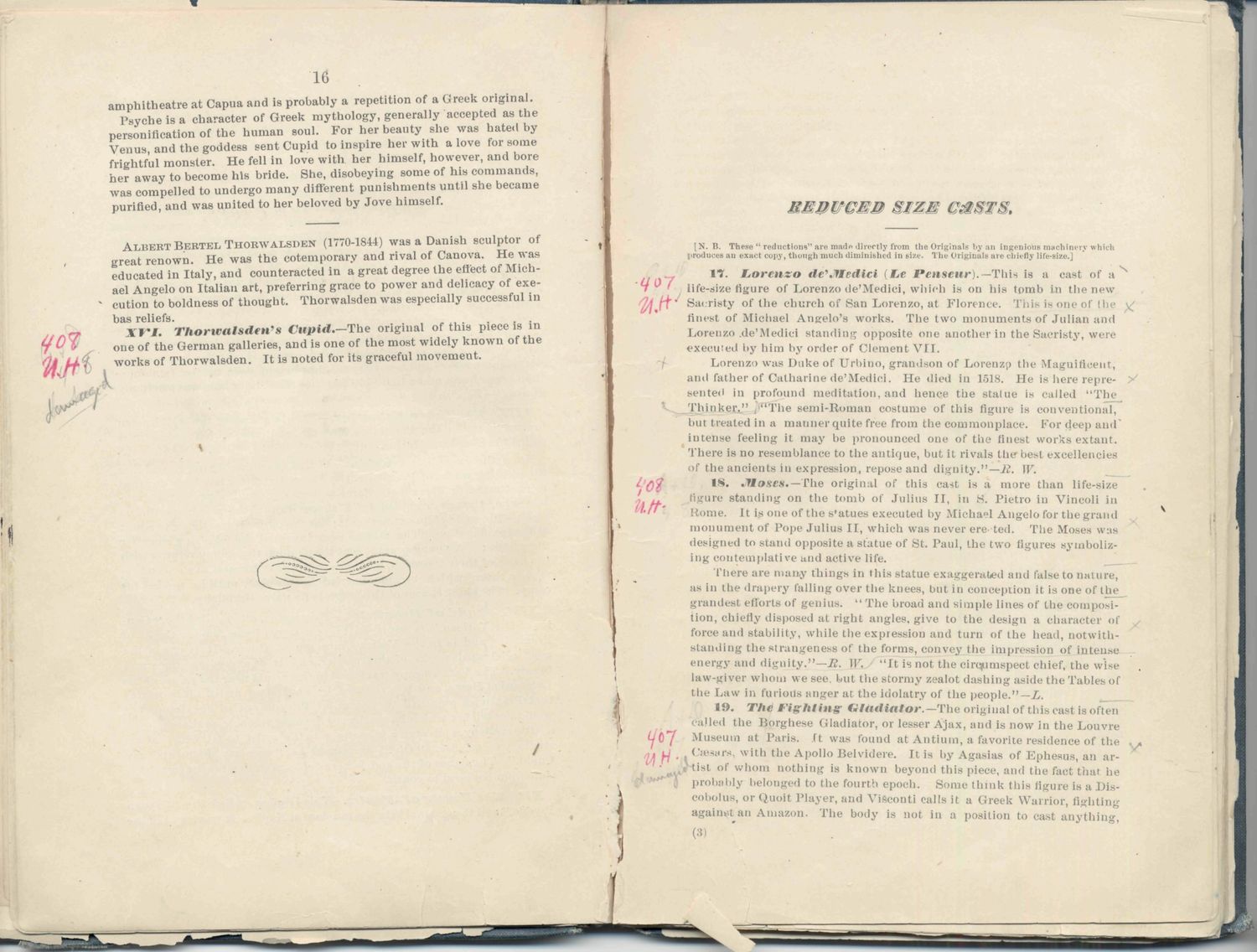| |
| |
Caption: Book - Gregory Art Collection Catalog (Gregory)
This is a reduced-resolution page image for fast online browsing.

EXTRACTED TEXT FROM PAGE:
1G amphitheatre at Capua and is probably a repetition of a Greek original. Psyche is a character of Greek mythology, generally accepted as the personification of the human soul. For her beauty she was hated by Venus, and the goddess sent Cupid to inspire her with a love for some frightful monster. H e fell in love with her himself, however, and bore her away to become his bride. She, disobeying some of his commands, was compelled to undergo many different punishments until she became purified, and was united to her beloved by Jove himself. A L B E R T B E R T E L T H O R W A L S D E N (1770-1S44) was a Danish sculptor of IWDl'VEB SIZE C^STS; /if\t? T * s %fti great renown. He was the cotemporary and rival of Canova. He was educated in Italy, and counteracted in a great degree the effect of Michael Angelo on Italian art, preferring grace to power and delicacy of execution to boldness of thought. Thorwalsden was especially successful in bas reliefs. XWM. Thortvatsden's Cupid.—The original of this piece is in one of the German galleries, and is one of the most widely known of the works of Thorwalsden. I t is noted for its graceful movement. [N. B. These " reductions" are made directly from theOriginals by an Ingenious machinery which produces an exacl copy, tbongh maeh diminished in size. The Originals are chiefly life-size.] I IT. liorenxo dc\ilcdicl i Lc Penseur).—This is a cast of a -ifO I Hfe-size figure of Lorenzo de'Mediei, which is on his tomb in the new OA ft' Sacristy of t h e church of San Lorenzo, at Florence. This is one of 11 finest of Michael Angelo's works. The two monuments of Julian and Lorenzo .de'Mediei standing opposite one another in the Sacristy, were executed by him by order of Clement V I I . Lorenzo was Duke of Urbino, grandson of Lorenzp the Magnificent, and father of Catharine de'Mediei. He died in 1618. He Ishererepre- y sen ted in profound meditation, and hence the Statue is called " T h e Thinker." " T h e semi-Roman costume of this figure is conventional, but treated in a manner quite free from the commonplace. For deep a n d ' intense feeling it may be pronounced one of the finest works extant. There is no resemblance to the antique, but it rivals the nest excellencies of the ancients m expression, repose and dignity."—R. II'. IS. Moses,—The original of this ca*l is a more than life-size figure standing on the tomb of Julius I I , in 8. Pietro in Vincoli in M •'•/'' Rome. It is one of the s'atues executed by Michael Angelo for the grand monument of Pope Julius If, which was never ere ted. The Moses was designed to stand opposite a statue of St. Paul, the two figures symbolizing contemplative and active life. There are many things in this statue exaggerated and false to nature, as in the drapery tailing over the knees, but in conception it is one of the grandest efforts of genius. " T h e broad and simple lines of the composition, chiefly disposed at right angles, give to the design a character of force and stability, while the expression ami turn of the head, notwithstanding the strangeness of the forms, convey the impression of intense energy and dignity."—22. IF. " I t is not the oircjimspect chief,- the wise law-giver whom v e see. hut the stormy zealot dashing aside the Tables of the Law in furious anger at the idolatry of the people."—!/. 1}>. The Fighting €iladinlor. —The original of this east is often called the Borghesc Gladiator, or lesser Ajax, and is now In the Louvre Lj(j"f Museum at Paris. It was found at Antium, a favorite residence of th Cffisars, witli the Apollo Belvidere. It is by Agasias of Ephesus, an arti.,t of whom nothing, is i i .i : ----. .. tist. „ r , „ l , . . „ . „ , . . l . ; . . . ;,. known beyondi this piece, and the fact thai he probably belonged to the fourth epoch. .Sonic think this figure is a Discobolus, or Quoit Player, and Yisconti calls it a Greek Warrior, lighting agaima an Amazon. The body is not in a position to cast anything.
| |